Many new inventions and technologies derive inspiration from nature. The practice of modeling artificial products after biological processes is called biomimicry or biomimetics. Janine Benyus, co-founder of the Biomimicry Institute, popularized the term in her 1997 book, Biomimicry. “Biomimicry,” she wrote, “is basically taking a design challenge and then finding an ecosystem that’s already solved that challenge, and literally trying to emulate what you learn.”
As scientists studying the natural world reveal their findings, inventors and engineers are drawing from these new revelations and applying nature’s solutions to new technology. Whether the problems researchers are looking to solve involve building better robots, tracking cancer cells more efficiently or improving telescopes to study space, a useful solution can be found in living things.
Here are ten findings from 2020 that could one day lead to new inventions.
Suckerfish Surf on the Backs of Other Sea Creatures
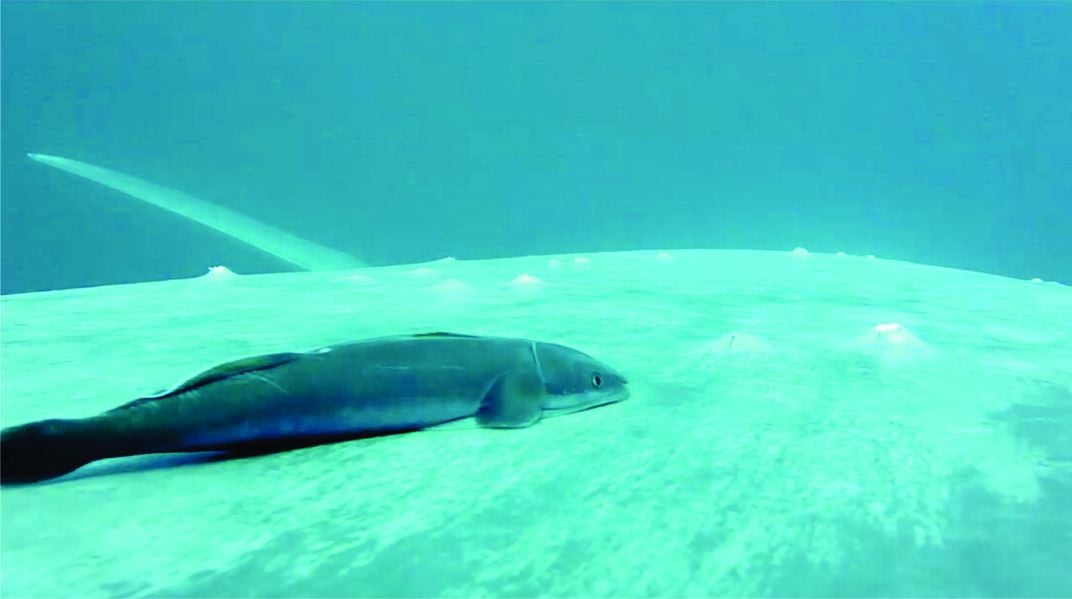
Remoras are the ocean’s hitchhikers. Also known as suckerfish, whalesuckers or sharksuckers, the one-to-three-foot long swimmers anchor themselves to blue whales or zebra sharks with a suction cup-like disc that “sits on their head like a flat, sticky hat,” according to the New York Times. But these suckerfish aren’t just mooching a free ride. This year, researchers found that the fish can actually “surf” along their chauffeur’s back while the pair is in transit. The remoras glide along their host’s body, clustering near a whale’s blowhole and dorsal fin where there is minimal drag—all the while nibbling on dead skin and parasites.
Researchers Brooke Flammang, Jeremy Goldbogen and their teams found that the remora’s choice location is key to hanging on. The area between the blowhole and dorsal fin, especially on blue whales, has “much lower-velocity fluid” than if it were “just a few centimeters higher” on the whale’s body, Flammang tells the Times.
The fish’s “sucking disc” isn’t actually sticking up against the whale’s skin either. Instead it hovers just above, creating a low-pressure zone that sucks the fish close to the whale and prevents it from flying off into the abyss—most of the time.
Flammang, a biologist at the New Jersey Institute of Technology, has already gotten to work on an artificial suction disk inspired by the remora that she hopes will be used to attach cameras and tracking devices to endangered marine animals, like blue whales. Currently, researchers use regular suction cups to fasten cameras to their research subjects, but those only keep their grip from 24 to 48 hours. Flammang’s new device will stay on for weeks and reduce drag. She and her team are currently testing the disc on compliant surfaces as well as designing a remora-shaped casing for the camera. Eventually, they’ll field test the device on live animals, including whales, dolphins, sharks and manta rays.
“Bioinspired advances in attachment developed by Dr. Flammang's lab will revolutionize how we are able to get tags on animals with greater success and efficacy,” Goldbogen, a marine biologist at Stanford University, writes to Smithsonian magazine. “Maybe future tags could not only attach but also surf and crawl just like remoras to the ideal spot for specific physiological sampling.”
Fish Fins Are as Sensitive as Fingertips
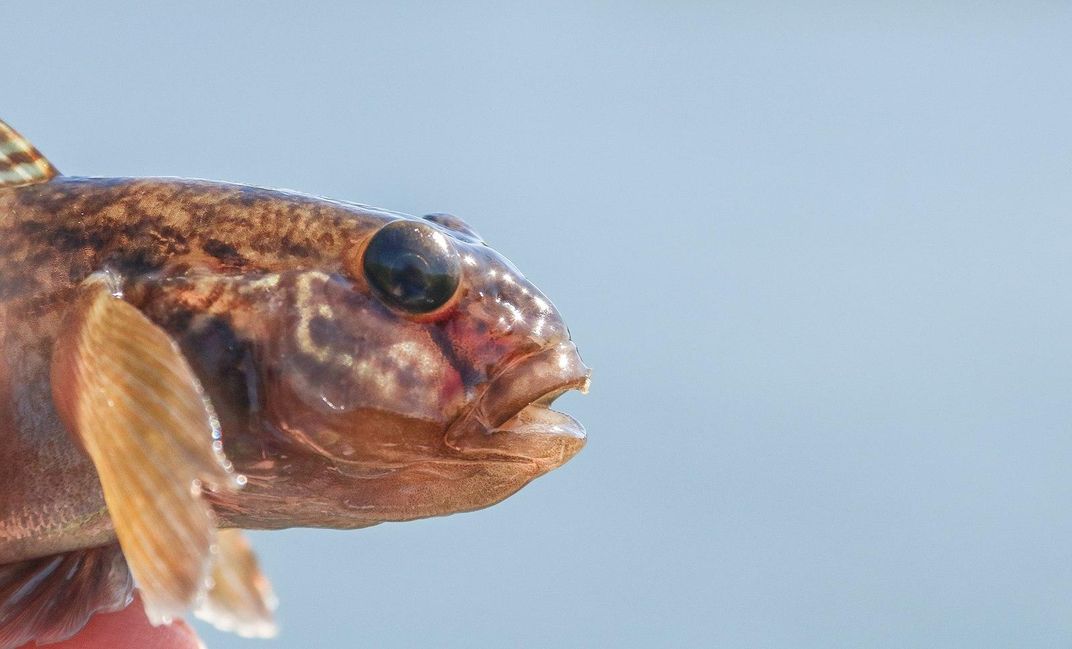
Fish fins aren’t just for steering and swimming, University of Chicago neuroscientist Adam Hardy and his lab found this year. In fact, the researchers discovered that fins are as sensitive as primate fingertips. To reach this conclusion, the scientists studied round gobies, a type of bottom dwelling fish native to places like the Black Sea and the Caspian Sea, but invasive populations live anywhere from European rivers to the Great Lakes. These little critters are known to “perch” on rocks, brushing their fins along the rock bed of lakes.
To determine how sensitive the gobies’ fins were, the team injected euthanized fish with a saline solution that kept their nerves operating normally during their experiment. They then used a special device to record the patterns of electric impulses the nerves produced when the fish’s fins brushed up against a ridged wheel. This measure showed the team that fins’ were perceiving “really fine detail,” study coauthor Melina Hale, also a neuroscientist at the University of Chicago, told Science News.
The researchers hope this discovery can inspire advancements in robotic sensory technology, especially in underwater bots.
The Diabolical Ironclad Beetle’s Exoskeleton Is Indestructible
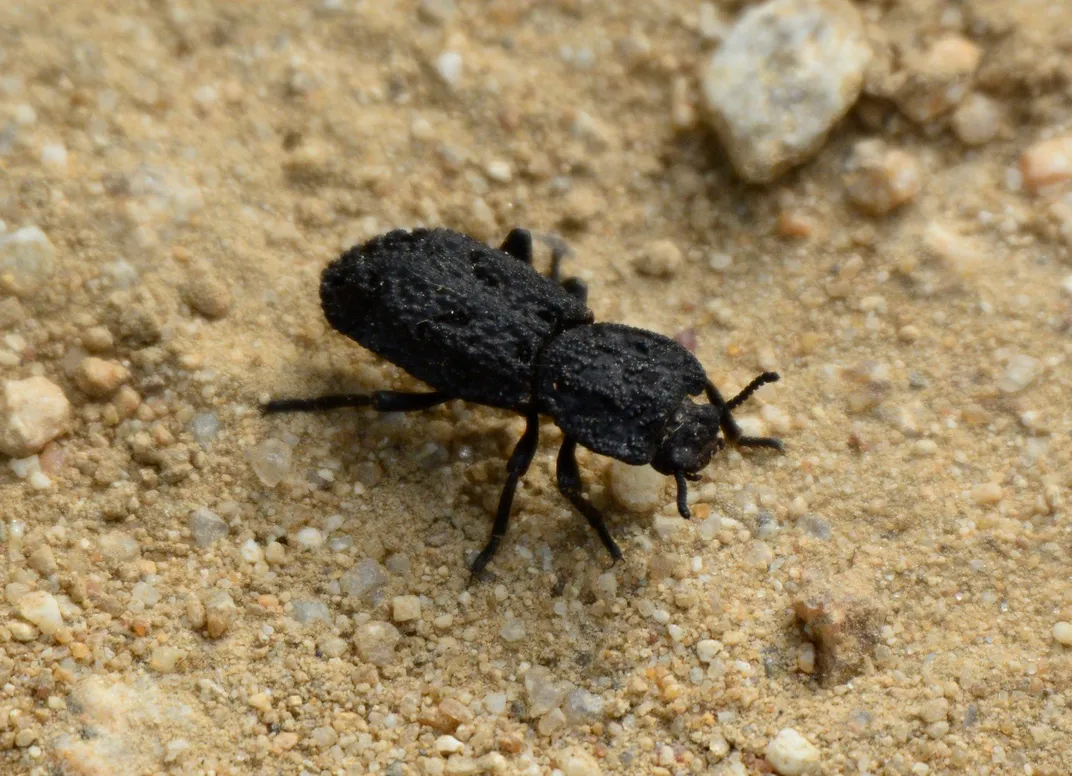
The diabolical ironclad beetle absolutely lives up to its name. While most bugs live only a few weeks, these beetles have a lifespan of about eight years, which is roughly the equivalent of a human living several thousand years. To achieve such a feat, they’ve evolved some remarkable armor.
The roughly inch-long insect can survive being run over by a car—and if you can’t believe that, University of California, Irvine engineer David Kisailus and his team piled in a Toyota Camry and ran one over twice, and it lived. After several more technical experiments, the team found the beetle can withstand immense pressure—up to 39,000 times its own body weight.
Several factors contribute to the beetle’s sturdiness. The beetle’s exoskeleton is flat, not rounded, like a ladybug, for instance. Within the exoskeleton are protein-rich layers, which can shift individually without the entire shell breaking. The two halves of the shell are joined together like a puzzle piece. The layers follow the puzzle-like curves, reinforcing the thinnest part of the joint—the neck-like bit where the two halves are interlocked.
In their paper, the researchers suggest a beetle-inspired interlocking fastener could perhaps replace similarly-shaped, but layer-less, joints used to secure airplane turbines. The team created a 3-D printed model complete with “lamination,” or layers. They predict this finding could introduce “immediate benefit over aviation fasteners, providing enhanced strength and substantial increased toughness.” But really, this design could be used anytime two different materials—like metal and plastic—need to be conjoined, such as in bridges, buildings and vehicles, too.
The Ultra-Black Pigmentation of Sixteen Species of Deep-Sea Fish Is Explained
/https://tf-cmsv2-smithsonianmag-media.s3.amazonaws.com/filer/b6/c1/b6c117fe-c2bf-4bc5-b0cb-28d7ae908028/karen_-_idiacanthus_1450747-25sm_no_watermark.jpg)
When National Museum of Natural History marine biologist Karen Osborn and her team accidentally pulled up a deep ocean fangtooth fish in their net of crabs, they tried to take its picture. But try as they might, details of the jet-black fish couldn’t be captured. The fish was literally unphotogenic, they later learned, because its tissue was absorbing 99.5 percent of the light from a camera’s flash.
The fangtooth, and 15 other species included in the study, sport ultra-black pigmentation that allows them to blend in to the pitch-dark environment of the deep ocean. Though light can’t reach this part of the ocean, some fish are bioluminescent. For sneaky predators, camouflaging into the dark abyss—or better yet absorbing light—is nature’s best invisibility cloak.
Plenty of animals on land and sea have very black coloring, but human-made color reflects around 10 percent of light and most other black fish reflect 2 percent of light. To cross the ultra-black threshold, these 16 species had to only reflect .5 percent of all light shining their way. These species achieved this feat with densely-packed, jumbo-sized, capsule-shaped melanosomes, or cells containing dark pigment. In other black, but not ultra-black, animals, melanosomes are loosely spread out, smaller and rounder in shape.
By imitating the shape, structure and dispersion of the ultra-black fish’s melanosomes, materials scientists may be able to create artificial ultra-black pigment. This pigment could be used to coat the inside of telescopes to get a better view of the night sky or improve light absorption on solar panels. It could even interest Naval researchers, Osborn told Smithsonian in July. “If you were to make, let’s say, armor that had melanin on the outside, you would be great for night ops,” she says.
When Soaring From Tree to Tree, Tropical Snakes Undulate for Stability
As if ground snakes and swimming snakes aren’t enough, five species of snakes “fly.” To be fair, this flight is really more like highly-coordinated fall. It looks sort of similar to the wriggling and side-winding they do on land, but with the help of gravity. Or as Virginia Tech biomechanics researcher Jake Socha told the New York Times, snake flight resembles a “big, wiggly, ribbon thing.”
The snakes flatten their round torso into a flattened, triangular shape in order to catch more air and glide from one tree to another, sometimes dozens of feet away. But the whole side-to-side, loopy lunges they do in the air didn’t make as much sense to scientists. That is until Socha and his team rented out Virginia Tech’s four-story black box arena called the Cube. In it, they outfitted seven flying snakes in reflective tape and recorded their leaps on high speed cameras more than 150 times. (Don’t worry. The team had to pass snake safety protocol, and the arena was equipped with foam floors and fake trees.)
Snake flight happens really fast, so the reflective tape allowed the team to recreate the flight using 3-D computer modeling. The team found that the snakes undulated vertically twice as often as they did horizontally, moving their tail up and down as well. Virginia Tech mechanical engineer Isaac Yeaton told the Times, “Other animals undulate for propulsion. We show that flying snakes undulate for stability.”
The team hopes their findings can be used to create some kind of flying snake search-and-rescue robot. Yeaton says the advantage of snake-inspired robots is their stable locomotion and ability to sneak through tight spaces that might cause your typical bot to trip or fall. He’s got his sights set on perhaps one day creating a bot that can mimic all of the snake’s twists, flexes, swerves and wiggles into one single robot.
“Combining them together, you could have one platform that could move through complex environments: the robot can ascend a tree or building, quickly glide to another area, and then slither or swim somewhere else,” Yeaton tells Smithsonian magazine via email. “There are engineering challenges to doing this, but I’m inspired by how capable the real flying snakes are and recent advances in bioinspired design.”
Small, Tadpole-Like Sea Creatures Make Slimy Inflatable Filtration Systems
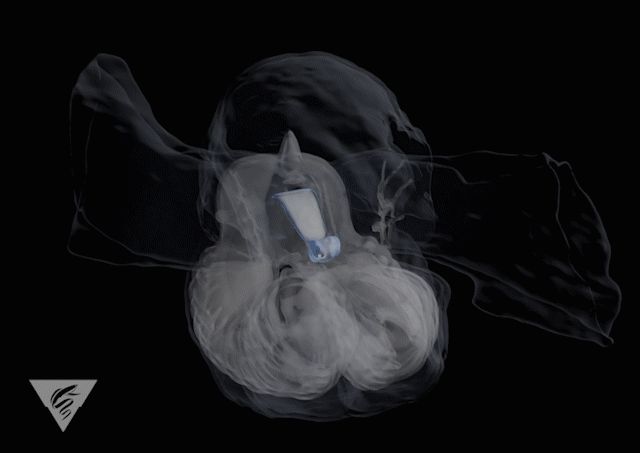
Giant larvaceans are shaped like tadpoles, only slightly larger; their bodies measure up to four inches in length. These tiny creatures live freely hundreds of feet below the sea surface, where food sources are scarce.
This year, researchers used laser scanning tools to unveil the complex “snot palaces” the creatures build, as study author and bioengineer Kakani Katija of Monterey Bay Aquarium Research Institute calls the structures. These tiny armless, legless creatures use their own secretions to construct elaborate clouds of snot complete with chambers, ribbed walls, tunnels, halls and chutes.
Much like spiders and their webs, larvaceans use these mucousy structures to capture tiny, sparse food particles floating by. Their little body sits in the middle of the “house,” while they wag their little tail to pump water through the labyrinth of channels and into their mouths—almost like an elaborate plumbing system of sorts. The cloud doubles as an invisibility cloak by concealing the critter’s motion in the dark depths where any false move is a death sentence.
Katija hopes to pull inspiration from these critters to one day create a biomimetic inflatable filtration system. Given that these animals can filter out particles smaller than viruses, perhaps medical-grade or HEPA filters could be improved with such a device.
“We’re still in the discovery phases of this project, and I’m hoping other researchers will pick up the torch,” Katija tells Smithsonian magazine via email.
An Iron-Packed Protein Is Key to a Tube Worm’s Glowing Blue Goo
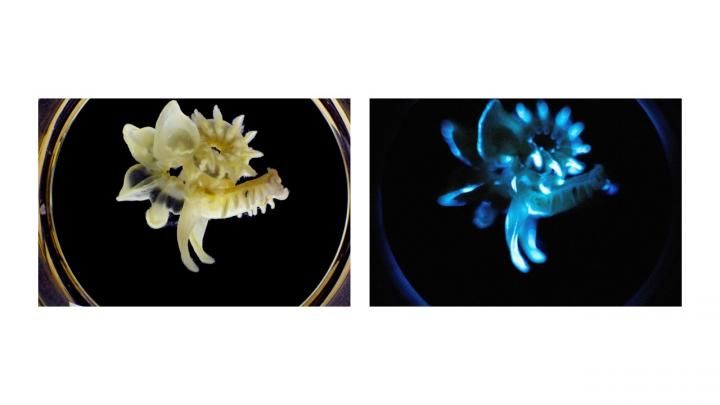
The flashes of bioluminescent critters, like fireflies, typically last from less than a second to at most 10 seconds. But not the marine parchment tube worm—these ocean swimmers produce a bright blue goo that stays aglow for anywhere from 16 to 72 hours. Because the slime keeps shining outside of the worm’s body, it doesn’t waste the organism’s energy, which is great for the worm’s survival, but begs the question: How does it keep glimmering for so long?
University of California, San Diego researchers Evelien De Meulenaere, Christina Puzzanghera and Dimitri D. Deheyn examined the complicated chemistry of the worm’s mucus and found that it contains an iron-packed protein called ferritin, which emits ions, or electrically charged atoms. This form of ferritin reacts with the blue light, triggering more ion production, which in turn keeps the light glowing in a feedback loop.
The team hopes to replicate the tube worm’s unique photoprotein—or a protein linked to bioluminescence—to illuminate cancer cells during surgery. On a simpler note, Deheyn also says they could develop a synthetic biological battery of sorts that could be used in emergency situations when electricity is out. He compares the idea to glow-in-the-dark stickers.
“Glowing stickers keep glowing because they accumulated sunlight from the day and release it night,” he tells Smithsonian. “Now imagine you don’t need sunlight, you would just need to add iron. These kinds of applications could be used as portable biological lights for emergency use. For example, maybe you need light on a landing pad for helicopters or planes in a power outage.”
Bumblebees May Know How Big They Are
Bumblebees have a reputation for clumsiness, but perhaps that’s a bit of a misjudgment on our behalf. One summer day, engineer Sridhar Ravi of the University of New South Wales in Canberra was watching bees navigate around branches and shrubs with ease. He was shocked that an organism with a rather small brain is capable of overcoming these challenges.
To put the bees to the test, Ravi and his team connected a tunnel to a beehive in their lab. They placed a narrow gap inside the tunnel as an obstacle and made it smaller and smaller over time. When the gap was smaller than the bees’ wingspans, they paused to scan the opening and then turned sideways to get through the gap without damaging their wings. Accomplishing even this small feat requires some awareness of how big one’s body is from different angles, an aptitude that insects aren’t generally thought to possess.
But if small-brained bees can handle it, Ravi says robots may not need big complicated processors to get better at navigating their surroundings. “Complex perceptions do not need sophisticated, large brains and can be achieved at small size scales with much fewer neurons,” he tells Smithsonian. This idea is exciting to consider when thinking about developing less-clumsy robots. Hopefully, the researchers can use their findings to improve robotic flight or swimming abilities.
“The graduation from merely sensing to be able to perceive will be mark an epoch in the field of robotics,” Ravi says.
A Leaf-Cutter Ant’s Body Armor Has an Extra Mineral-Based Protective Coating
/https://tf-cmsv2-smithsonianmag-media.s3.amazonaws.com/filer/d3/d8/d3d8954d-1e0a-4148-adb2-728fe5dc39e3/112320_cwi_ant_feat-1030x580.jpg)
When evolutionary biologist Hongjie Li realized the leaf-cutter ants he was studying had a thin layer of mineral body armor, he told his colleague: “I found rock ants.”
To study the ant’s exoskeleton further, the coating would need to be removed, but how? Li had an epiphany while brushing his teeth, he tells Science News. Mouthwash removes plenty of junk from our teeth without damaging our cheeks, gums and tongue. His hunch did the trick, and mouthwash dissolved the mineral coating without damaging the exoskeleton. Through more traditional lab experiments, the team determined the mineral coating is made of calcite with a high concentration of magnesium. In sea urchins, this mixture of calcite and magnesium is thought to make the small “stone tip” of its tooth capable of grinding through limestone.
“Integration of magnesium in calcite could be especially beneficial for any nanotechnology that involves the use of calcite, such as in plastics, adhesives, construction mortar and dentistry,” explains study authors Cameron Currie and Pupa Gilbert in an email to Smithsonian magazine.
Furthermore, the mineral coating isn’t something the ants are born with, but something they can develop in a snap when they need it, Currie explains.
“It is incredible that our ants are able to massively improve on this projection by rapidly forming a thin and light nanocrystal coating,” he says. “This highlights the potential application of nanomaterial coating like this to improve body armor.”
Some Moths Have an Acoustic Cloak That Dampens Bat Sonar
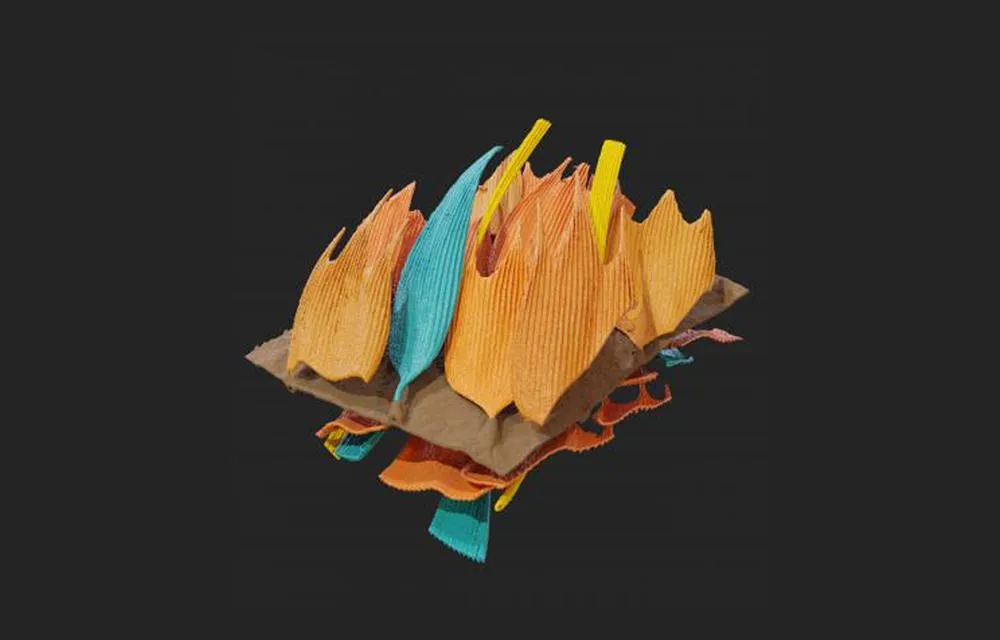
To be a moth desperately hiding from a predator that uses sound to “see” is no easy feat, but some of these winged insects have evolved impressive features to shield themselves from bats.
In addition to sound-softening fur, two earless moth species have fork-shaped scales on their wings that help absorb bat sonar, researchers found earlier this year. Individual moth's wings are covered in tens of thousands of these tiny scales, each one less than millimeter long and just a few hundred micrometers thick. Each scale warps the sound of the wing, slowing down its acoustic energy and in turn, reflecting less sound back to the bats. The scales seems to resonate at a different frequency and as a whole, they can “absorb at least three octaves of sound,” reports Anthony King for Chemistry World.
“They are highly structured on a nanometre scale with strongly perforated corrugated top and bottom layers that are interconnected by a network of minute pillars,” study author Marc Holderied of the University of Bristol tells Chemistry World.
Holderied estimates moth-inspired soundproofing techniques could make materials “10 times more efficient at absorbing sounds.” Rather than installing bulky panels in homes and offices, he envisions sound-absorbing wallpaper coated with scale-like nanostructures.
Holderied could also see this finding having broader industry-level applications as well. “We are indeed very excited by the broad application prospects of this material,” he tells Smithsonian. “Any field from architectural to machine and transportation acoustics, where sound absorption with reduced footprint is of benefit, would profit from thinner moth-inspired solutions.”
:focal(314x274:315x275)/https://tf-cmsv2-smithsonianmag-media.s3.amazonaws.com/filer/c4/7e/c47eecea-986d-4585-944e-2db42351be7a/fish-mobile.jpg)
:focal(417x142:418x143)/https://tf-cmsv2-smithsonianmag-media.s3.amazonaws.com/filer/5f/df/5fdf9cb3-6b10-413f-b933-e2846cfb9e75/fish.jpg)
/https://tf-cmsv2-smithsonianmag-media.s3.amazonaws.com/accounts/headshot/rachael.png)


/https://tf-cmsv2-smithsonianmag-media.s3.amazonaws.com/accounts/headshot/rachael.png)